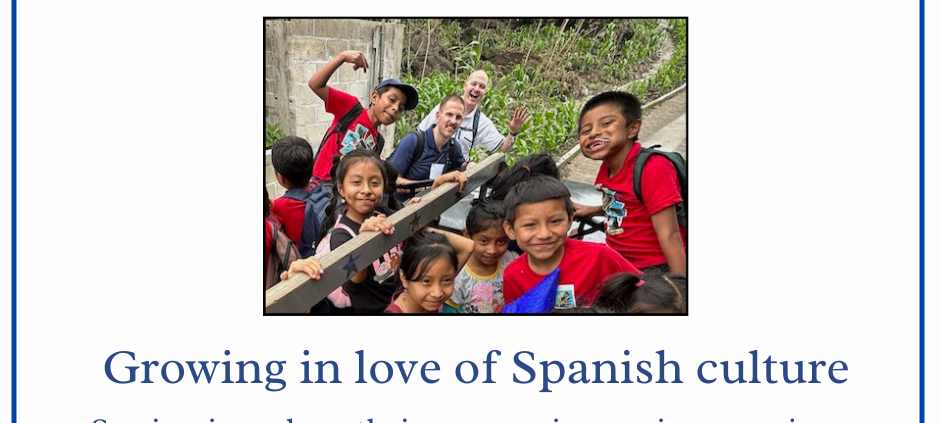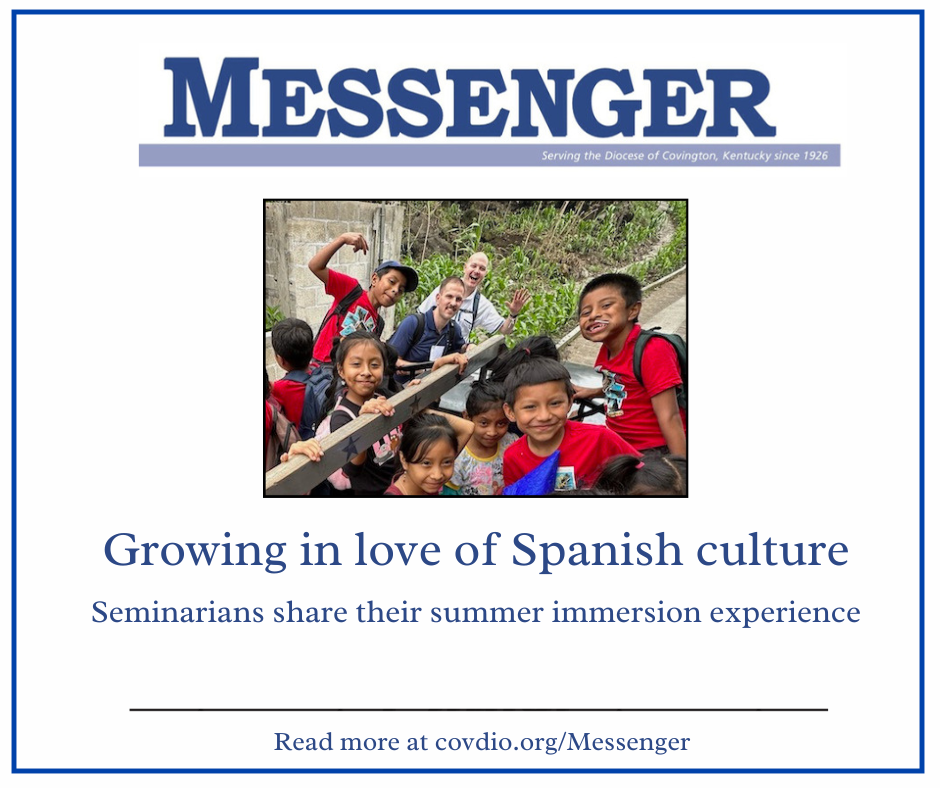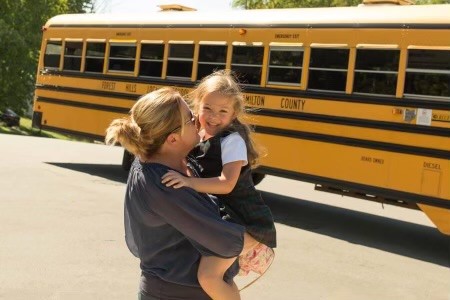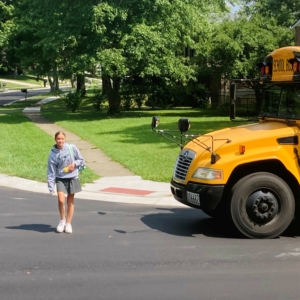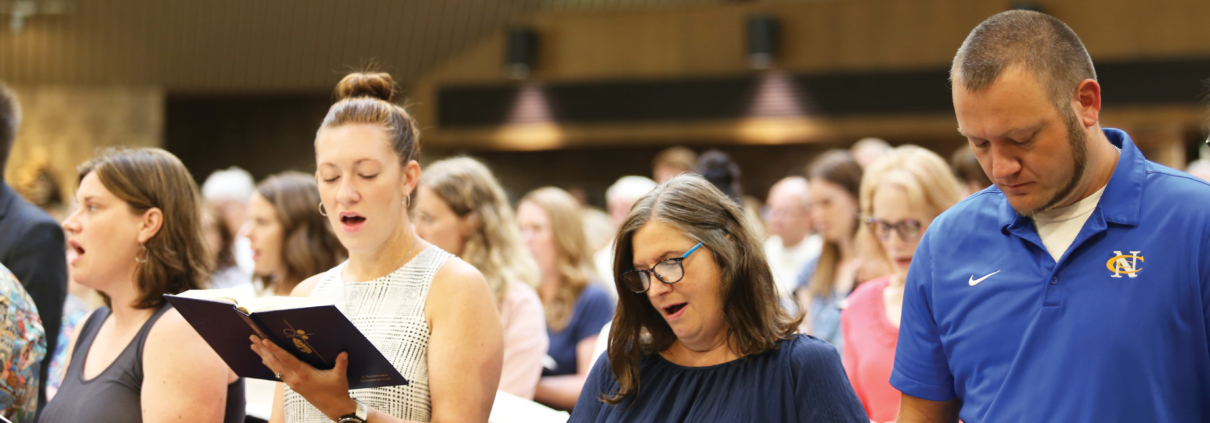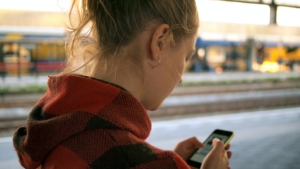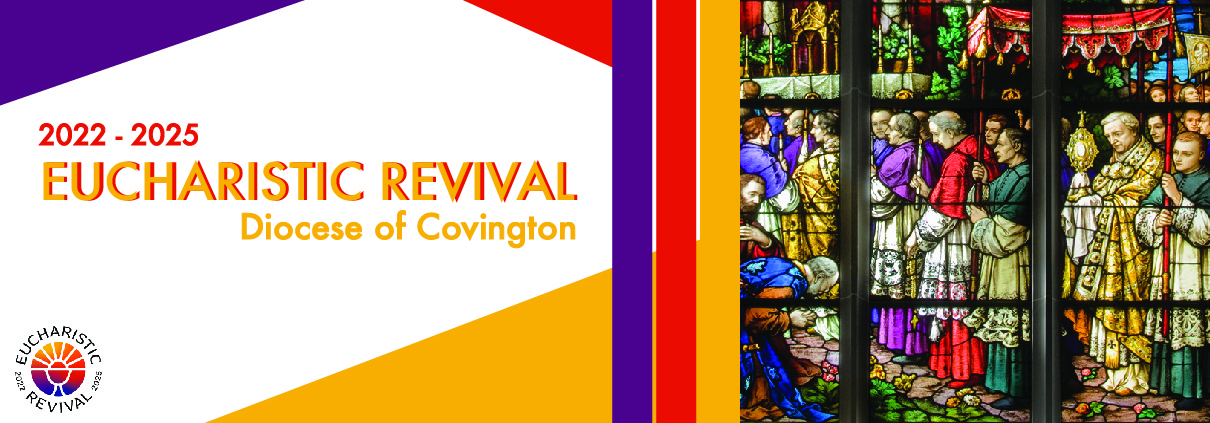Archive for year: 2023
Seminarians grow in love of Spanish language and culture
Hank Bischoff, Joshua Heskamp, and Michael Schulte share photos and stories of their summer Spanish immersion experience in San Antonio, Texas and Antiqua, Guatemala. Read more on page 3: https://covdio.org/wp-content/uploads/2023/08/9328Messenger25Aug2023-1.pdf
Christ-centered: at school, and at home
By Kendra McGuire.
Another summer has come and gone and we find ourselves quickly settling back into the school year routines. As we begin this new school year, our school communities share similar hopes and expectations.
Our faculty, staff, parents, and students all long for a successful year with great growth in learning. We hope for positive relationships that are cooperative and share common goals. But above all, we long to be part of a school community where everyone is welcome, everyone is loved, and everyone feels that they are an important part of the school.
In order for our school communities to meet these hopes and expectations, we have to recognize that Jesus Christ must be the center of all we do. In the book of James 1:17, we learn that “all good giving and every perfect gift is from above.” Together, we must put our faith first and be willing to serve where God calls us. By serving Him, we will become instruments through which God’s gifts of peace, love and joy will flow and fill our schools.
In early August, the teachers in our Catholic schools gathered together to focus on putting our faith first. We learned about the importance of prayer in our lives and discussed new ways to increase prayer in our classrooms and in our schools. We studied Sacred Scripture through the lens of a teacher to learn how Jesus, the Master Teacher, models great teaching. And we learned how we are all called to invite others to choose a relationship with Jesus Christ.
As I reflect upon the learning our teachers experienced, I believe it is helpful to think about this as parents too. We should stop and think about how we pray in our homes. Is it only before meals? Do we pray together as we head to school? This year, resolve to “pray without ceasing” (1 Thessalonians 5:17) in your home and with your children.
Our homes should also include the study of Sacred Scripture. We are called to live as Jesus lived, to model our actions after Him. Reading a Bible passage together daily or in preparation for Sunday Masses would be a great way to learn about Jesus and open the door to conversations about God and how He works in our lives.
As parents, the primary teachers of our children, we have a responsibility to call them into communion with Jesus. How often does Jesus come up in our conversations? When our children are struggling with the daily challenges of life, do we invite them to pray, visit with Jesus in Adoration, or go to Mass? Do we take them to Mass every Sunday where we can remind them that we go to give glory and praise to God for all the good gifts He has given to us?
This school year, let’s keep our expectations high and hold on to hope for great things. The faculty and staff in our schools are already working hard to help their students learn. We know they will lead our children in prayer and worship and create Christ-centered classrooms.
As parents, let us also make a commitment to strengthen our school communities further by making our homes Christ-centered too. When our communities are united in Jesus Christ, both at home and school, then they will reflect the love of Jesus Christ and become places where all will be welcomed, loved, and filled with great joy!
Kendra McGuire is superintendent of Schools for the Diocese of Covington, Ky.
Prayer and Gratitude will get you through school and life
By David Cooley.
It’s that time of the year again that’s filled with both excitement and anxiety for students, teachers, and parents alike. For most of us the summer is already out of reach, but a new school year brings with it an opportunity for a fresh start and new adventures.
Still, August and everything that comes after can be a little overwhelming. There is always so much to do and lots of pressure to get the school year off to a good start. With all the paperwork, school rules, bus routes, uniforms, practices, homework, etc., it’s important that we find balance each day. And there is only one way to ensure balance. Prayer, our ongoing conversation with God, must be our anchor in our day-to-day life if we are going to have any sense of peace.
The best way we can help our young people navigate through this life is to teach them the art of daily prayer — the importance of finding a place to be quiet and shut out all the noise — and to challenge them to find things to be grateful for every day. Prayer and gratitude, these are treasures of a Catholic school.
I don’t have to tell you that childhood today is very different than when we were growing up. But remember, it was a lot different for us than it was for our grandparents. Yet, it seems that many young people in our time are struggling with finding joy. Perhaps without all this technology it was easier to find the simple joys of life. The antidote to this problem is prayer and gratitude.
Children always have and will always need the same things. They need love and family, they need structure and recreation, they need friendship and a sense of understanding who they are in the eyes of God. They need to be humble, but also recognize they have a great purpose in life.
If we are to teach our children to be grateful, then we need to be grateful ourselves. Our gratitude and positive attitudes must be visible to young eyes. Teachers are, after all, witnesses. It is very fitting that in the Diocese of Covington, Bishop Iffert’s episcopal motto is “In all things give thanks,” (Thes 5:18). It is not easy, but it is life changing.
I want to begin this year by expressing how grateful I am for Catholic schools.
First and foremost, Catholic schools provide opportunities every day for students and faculty to encounter Christ. Our schools are at their best when they are providing the opportunity to receive Jesus in the sacrament of His Most Holy Body and Blood — what a gift!
Catholic schools are a place where we find an extended family, people who understand that we are all on this journey together to get to heaven. As the culture becomes more and more secular, Catholic schools are safe havens and beacons of light in the growing darkness. There aren’t many places left where we can trust our young people aren’t being bombarded with all kinds of unhealthy messages.
Catholic schools help our young people prioritize what is really important in life. By orienting their lives toward Christ and to serving others, things begin to make more sense. Sports, art, academics, video games, etc., all have a place, but a good school teaches children that God comes first. If a child learns early to put God first in everything they do everything else will fall into place.
Catholic schools teach children that we are all made in the image and likeness of God, and therefore every individual is unique and has an undeniable dignity as a child of God. This is important because it helps them understand more profoundly why things like bullying is wrong, why we need to respect our bodies and the bodies of others. It isn’t just, “This is wrong because the teacher said so;” it’s a lot deeper than that. Seeing the world this way, helps people learn to love themselves and others.
I could go on and on about why I am grateful for Catholic schools. I am so thankful for the many years I spent in Catholic schools myself and that I am now able to send my own children to Catholic schools.
I think if I had to sum it all up I would say that Catholic schools are a blessing because they minister to the whole person — mind, body and soul. There is a lot to unpack in that statement, and there are a lot of happy accidents in the results when you minister to children this way. Graduating from our schools we see good citizens, we see artists, we see doctors, we see famers, we see firefighters, teachers, the list can go on and on. But most importantly, graduating from our schools we see disciples of Christ, who are going to go out and make this world a better place.
Catholic schools teach us to be grateful to God for our life, for His love, and for His mercy, and they teach us to treat other people accordingly.
David Cooley is co-director of the Office of Catechesis and Evangelization in the Diocese of Covington.
Parishes create unique Eucharistic encounters through 40 hour devotions
Laura Keener, Editor
In a recent Sunday Gospel, Peter and the other disciples are in a boat on the sea as the wind and waves are kicking up. Jesus, on the shore, proceeds to walk on the water towards them. Peter asks Jesus to call him to him. Jesus does, and Peter leaves the boat and walks on the water towards Jesus.
“Peter wanted to have a unique encounter with Jesus,” said Father Daniel Schomaker, diocesan director, Worship and Liturgy Office. “He had to get out of the boat in order to do that. He had to get out of the safety of the boat — his comfort area — in order to have an encounter with Jesus.”
Today, Jesus still invites his disciples — you — to a unique encounter with him in the Eucharist — communally at Mass but also individually at adoration. The Catholic Church in the United States is in the middle of a three-year Eucharistic Revival.
This year, on the feast of Corpus Christi in June, the Eucharistic Revival transitioned from the diocesan phase to the parish phase. To help unite the parishes around the Eucharist, Bishop John Iffert, at the request of the diocesan Worship Committee, has asked pastors to host 40 Hours of continual Eucharistic adoration. (See related article page 4.)
These 40 Hours will be scheduled sometime during the year, from now until July 2024, when the revival culminates with a Eucharistic Congress, July 17–21, 2024, at Lucas Oil Stadium, Indianapolis. Discounted tickets for the Congress are available through the diocesan Office of Worship and Liturgy; an application is online at covdio.org.
St. Augustine Parish, Covington, is the second parish to honor Bishop Iffert’s request to host the 40 Hours devotion. The Cathedral Basilica of the Assumption, Covington, who held 40 Hours on the feast of Corpus Christi, was the first. St. Augustine’s 40 Hours will begin Friday, August 5, 7 p.m. continuing until Sunday, Aug. 27, 5 p.m.
Father Schomaker said that at least two people need to be present during Adoration. This, he said, can be difficult for small parishes. To help accommodate parishes, adorers from all parishes in the diocese are welcome and encouraged to volunteer for a half hour or more of adoration at as many parishes as their time allows. Adorers can reserve their time at St. Augustine’s 40 Hours by visiting the parish website, https://www.staugustines.net.
“40 Hours devotions are being held throughout this Parish Eucharistic Revival year at different times so that the faithful will have the opportunity in their parish and at other parishes to spend time in Eucharistic Adoration,” said Father Schomaker. “This way, it’s a parochial celebration but it’s also a diocesan celebration, because we recognize that there is one local Church, which is the Diocese of Covington.”
Spending time in adoration may be new to some. The good news is there is no specific ritual to know, so it’s hard to do Adoration wrong. The only requirement is to come prayerfully and reverently to gaze at and listen to Jesus.
“The beauty of the Church is that her treasure trove of prayer is vast, and there’s not one way to pray,” said Father Schomaker. “In fact, most of the time, we need to remember that prayer requires listening. Prayer is not a monologue. It is a conversation. We have to be able to hear the Lord speak back to us.”
For anyone who likes a little structure in their prayer they are welcome to pray the rosary or the Liturgy of the Hours, or they can bring along some spiritual reading — a book of the saints or a saint, or bring a Bible.
“St. Augustine says that the Sacred Scriptures are love letters from home. Well, let’s read the love letters from the one who loves us,” said Father Schomaker.
The best part of Adoration is taking the time, putting oneself in the presence of the Eucharist, to have that unique encounter with Jesus.
“Peter had to get out of the boat. Sometimes we have to do that too, to get out of our comfort zone,” said Father Schomaker. “Today, the wind and the waves are oftentimes our culture that make quiet difficult. Silence is hard because we’re surrounded by all forms of noise. Get out of the boat. Enter into the silence. Go have an encounter with Jesus.”
Teaching in Catholic schools is a vocation, preaches Father Kidaagen at diocesan teacher Mass
Maura Baker, Staff Writer
Early August means the beginning of the school year, with teachers and school administrators preparing to re-open their doors to the hundreds of diocesan students who will be returning for 2023-2024 school year.
Educators gathered for Mass, Aug. 7, just days before the first schools were to return to session on Aug. 9. The Mass was celebrated at St. Pius X Parish, Edgewood, and celebrated by the parish’s pastor Father Baiju Kidaagen. Chaplains from schools across the Diocese of Covington concelebrated the Mass, as well.
“Some students will be excited, others may be anxious and some might not want to come at all,” said Kendra McGuire, superintendent of Schools for the Diocese of Covington as she gave opening remarks before Mass. “Our job is to invite them all with great joy and to welcome them and instill in them a wonder and curiosity about the learning that will take place in your classroom this year.”
Mrs. McGuire continued, “Our job is to help nurture their gifts and to help them realize that God created each and every one of your students for a purpose. We have a responsibility to show them the beauty of God’s creation — to seek the truth.”
In his homily, Father Kidaagen spoke of teaching in a Catholic school as a vocation, because “we know we cannot make it to Heaven alone and Catholic education involves all parties being united by God to a common goal, eternal life … your job is a vocation because what you are doing has not only a temporal, but also a supernatural dimension to it,” he added.
“In your work as Catholic educators, you are asked to form young people not simply to be a successful person in this world, but to be prepared to take their place in the Kingdom of God as God’s sons and daughters. If your job is a vocation, then you proclaim in a definitive way that Jesus must be at the heartbeat of everything you teach,” he said.
Before the closing of the Mass, the teachers in attendance rose for a commissioning by Father Kidaagen on behalf of Bishop Iffert, “No matter which subject you will teach, remember that your task as a Catholic school teacher is to teach our students love of God and love of neighbor.”
Photo: Various school teachers sing along during the Mass service.
Seeing and understanding
By David Cooley.
In the 13th chapter of the Gospel of Matthew Jesus’ disciples ask him why he speaks to the people through parables. He answers: “… because they look but do not see and hear but do not listen or understand.” (Matt 13:13) He goes on to explain that the people he is talking about fulfill an ancient prophecy of Isaiah: “You shall indeed hear but never understand, and you shall indeed see but never perceive.” (Isaiah 6: 9-10)
Jesus’ parables are always fascinating but what’s striking in the passage above is how he refers to those who aren’t following him. What does it mean to be a person that looks but does not see, or a person that hears but does not understand? And how can disciples of Jesus today be sure to be people who truly see and understand?
I often think of Pope St. John Paul II and the world in which he grew up. Observing the horrible ways that so many human beings were treated in the first have of the 20th century had a profound impact on him. He realized early on how important it is that we understand who we are and how we ought to act in the world. His teachings on the Catholic understanding of the human person are often referred to as the Theology of the Body.
The understanding of what it means to be a human person in light of Scripture, helps us to understand how we were created, our identity in Christ and our gifts so that we may see ourselves and others the way God intended.
Today, children are growing up immersed in social media. While it’s bad enough that traditional childhood activities are set aside in order to digitally “follow” others, create Tik Tok videos and stay up to date on the latest trends, what is even more worrisome is how young people are learning to perceive themselves and others. The line between what is real and what is not real is continuously becoming more and more blurred.
Since all of creation has a message to tell, it is important that we pay attention. Since part of the mystery of God is revealed through the human body, it is important that we have a proper understanding of human sexuality. In today’s culture, young people are being formed to not see creation the way it was meant to be seen, to not see their bodies the way they were meant to be seen, and to not see others the way they are meant to be seen.
This is all part of what it means to be spiritually blind, and Jesus is constantly inviting us to become people that see. In a fallen world we must train our eyes to see God’s plan for creation and to see that God has a plan for all of us. Only then will we be able to explore the two fundamental questions from the Catechism of the Catholic Church — where do we come from? And where are we going?
The older generations must properly lead the younger generations. Adults have a perspective about life that young people lack. They can see the bigger picture simply because they have been around longer. It seems like every year more and more studies are coming out about the increases in depression and anxiety in young people. There is a direct correlation between these findings and the rise of social media. This makes sense because they are selling themselves short and not realizing that they are made for so much more.
Those of us who have been around for a little while need to make sure that we, ourselves, are close followers of Christ and reading the signs of the times in light of the Gospel. We cannot do that unless we are on our knees praying every day and making the sacrifices that we need to make.
Secondly, we need to lead by example. Children are always watching and learning from us — how are we spending our time? We also need to make sure that the line of communication is always open and that our young people know where to go for information when difficult questions arise.
Finally, we need to at least ask the question: Do young people need to be on social media at all? It is skewing their vision of the world and their vision of themselves. It’s warping their ability to establish and grow real relationships that they will need later in life. Worst of all, it is plunging them into a society that is loud, showy, fake and often manipulative. Social media trains the person to look but not to see.
Our technology is growing so fast that we are all at risk of missing the world we were meant to see and not becoming the people we were meant to become.
David Cooley is co-director and office manager of the Office of Catechesis and Evangelization in the Diocese of Covington.
Cross the Bridge for Life – Sunday, June 4, 2023
Join hundreds of participants for this peaceful, prayerful presence to advocate for the sanctity of human life. Now, more than ever, our voices need to be heard!
Please join us and bring your families. This is a collaborative event sponsored by the Diocese of Covington, Archdiocese of Cincinnati, and other Greater Cincinnati and Northern Kentucky life-affirming organizations. A great family event to share with all ages!
For more information, Click Here for Flyer or call the Diocese of Covington Pro-Life Office at (859) 392-1500.
Cross the Bridge for Life returns for first run post Roe v. Wade
Maura Baker, Staff Writer
With the month of May underway, the 2023 Cross the Bridge for Life is quickly approaching. This year, the event will take place June 4, at Festival Park, Newport. Festivities are set to begin at 1 p.m., with the namesake walk across the Purple People Bridge to begin at 2 p.m. Festivities for the 2023 Cross the Bridge for Life will include live music by Lee Roessler, face-painting and hot dogs donated by Bluegrass Meats.
The first Cross the Bridge for Life was held in 2005. Despite missing a few years due to the COVID-19 pandemic, the event returned last year.
“Every year it seems to get bigger, and we’re kind of rebuilding since COVID,” said Faye Roch, director of the Pro-Life Office for the Diocese of Covington and one of the event’s coordinators, “It did well last year, but we were in the midst of awaiting the Supreme Court decision (regarding the overturning of Roe v. Wade), so I think there was some fear with people attending last year, and it was a little bit harder to promote it.”
This year, however, now that Roe v. Wade has officially been overturned and abortion legislation has been returned to the states, Cross the Bridge for Life is hoping to see if the “decision made a difference in the attendance of the event.”
“We are trying to reach out ecumenically to a lot of the Christian protestant churches,” said Mrs. Roch, “to let them know about this event — because this isn’t about being Catholic. It’s not just a Catholic event. It’s about bringing our entire community together in support of the gift of life, at all stages.”
Register now for lottery to purchase discounted 2024 Eucharistic Congress tickets
OSV News — With contributions from Laura Keener, Editor
The Diocese of Covington has opened a lottery for its 250 discounted tickets to the 2024 Eucharistic Congress, July 17–21, at Lucas Oil Stadium in Indianapolis, Indiana.
The congress is expected to draw more than 80,000 people, and organizers have compared the event to World Youth Day, with prayer and liturgies, catechesis for individuals and families, and a festival-like atmosphere. Registration is expected to fill quickly, Tim Glemkowski, executive director of the National Eucharistic Congress, told OSV News in an interview.
In the Diocese of Covington, the cost of the discounted tickets is $100 each. Households may now go online — www.covdio.org — to register their name and the names of household members for an opportunity to purchase tickets. Tickets are non-transferrable. Children under two do not require a ticket, so their names would not be required. Single adult households may include the name of a guest. Registering households must be located in the Diocese of Covington.
Launched last year, the National Eucharistic Revival is a three-year campaign by the U.S. bishops to increase the Catholic understanding of and devotion to Christ’s real presence in the Eucharist. The Year of the National Eucharistic Congress and Missionary Sending 2024-25 is the third and final year of the U.S. bishops’ National Eucharistic Revival.
Part of the impetus for the campaign was a Pew Research Center study in the fall of 2019 that showed just 30 to 40 percent of Catholics understand and believe in the Real Presence. A more recent study conducted by the Center For Applied Research in the Apostolate at Georgetown University found that 50 percent of Catholics know the teaching on the Real Presence in the Eucharist and only 40 percent believe this teaching. The study also showed that only 15 percent of Catholics attend Sunday Mass on a weekly basis.
The revival opened June 19, 2022, on the solemnity of Corpus Christi, a feast that celebrates the Body and Blood of Christ. Many dioceses marked the day last year with Eucharistic processions.
Speaking to the media in November about the revival, Bishop Andrew H. Cozzens of Crookston, Minnesota, said the beauty and diversity expressed in those processions “capture what is at the heart of this movement, which is a movement that we seek to invite people to a transformative encounter with Christ in the Eucharist that they might be healed, unified and sent on mission.”
For additional information about the Eucharistic Congress and Revival or to purchase non-discounted tickets visit the Eucharistic Revival website, www.eucharisticcongress.org. The Messenger contributed to this article.

